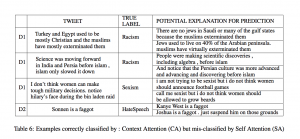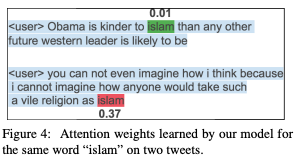Six Papers From the NLP & Speech Group Accepted to NAACL 2024
The 2024 Annual Conference of the North American Chapter of the Association for Computational Linguistics (NAACL) is a premiere annual conference for natural language research. Held June 16-21, 2024, in Mexico City, Mexico, researchers from the department presented work that covers language models, summarization, social media, code-switching, and sentiment analysis.
Associate Professor Zhou Yu and her team won a Best Paper Award for their paper Teaching Language Models to Self-Improve through Interactive Demonstrations. They introduce TRIPOST, a training algorithm that endows smaller models with self-improvement ability, which shows that the interactive experience of learning from and correcting its own mistakes is crucial for small models to improve their performance.
Below are the abstracts:
Teaching Language Models to Self-Improve through Interactive Demonstrations
Xiao Yu Columbia University, Baolin Peng Microsoft Research, Michel Galley Microsoft Research, Jianfeng Gao Microsoft Research, Zhou Yu Columbia University
Abstract:
The self-improving ability of large language models (LLMs), enabled by prompting them to analyze and revise their own outputs, has garnered significant interest in recent research. However, this ability has been shown to be absent and difficult to learn for smaller models, thus widening the performance gap between state-of-the-art LLMs and more costeffective and faster ones. To reduce this gap, we introduce TRIPOST, a training algorithm that endows smaller models with such selfimprovement ability, and show that our approach can improve LLaMA-7B’s performance on math and reasoning tasks by up to 7.13%. In contrast to prior work, we achieve this by using the smaller model to interact with LLMs to collect feedback and improvements on its own generations. We then replay this experience to train the small model. Our experiments on four math and reasoning datasets show that the interactive experience of learning from and correcting its own mistakes is crucial for small models to improve their performance.
TofuEval: Evaluating Hallucinations of LLMs on Topic-Focused Dialogue Summarization
Liyan Tang The University of Texas at Austin, Igor Shalyminov AWS AI Labs, Amy Wing-mei Wong AWS AI Labs, Jon Burnsky AWS AI Labs, Jake W. Vincent AWS AI Labs, Yuan Yang AWS AI Labs, Siffi Singh AWS AI Labs, Song Feng AWS AI Labs, Hwanjun Song Korea Advanced Institute of Science & Technology, Hang Su AWS AI Labs, Lijia Sun AWS AI Labs, Yi Zhang AWS AI Labs, Saab Mansour AWS AI Labs, Kathleen McKeown Columbia University
Abstract:
Single-document news summarization has seen substantial progress in faithfulness in recent years, driven by research on the evaluation of factual consistency or hallucinations. We ask whether these advances carry over to other text summarization domains. We propose a new evaluation benchmark on topic-focused dialogue summarization, generated by LLMs of varying sizes. We provide binary sentence-level human annotations of the factual consistency of these summaries along with detailed explanations of factually inconsistent sentences. Our analysis shows that existing LLMs hallucinate significant amounts of factual errors in the dialogue domain, regardless of the model’s size. On the other hand, when LLMs, including GPT-4, serve as binary factual evaluators, they perform poorly and can be outperformed by prevailing state-of-the-art specialized factuality evaluation metrics. Finally, we conducted an analysis of hallucination types with a curated error taxonomy. We find that there are diverse errors and error distributions in modelgenerated summaries and that non-LLM-based metrics can capture all error types better than LLM-based evaluators.
Fair Abstractive Summarization of Diverse Perspectives
Yusen Zhang Penn State University, Nan Zhang Penn State University, Yixin Liu Yale University, Alexander Fabbri Salesforce Research, Junru Liu Texas A&M University, Ryo Kamoi Penn State University, Xiaoxin Lu Penn State University, Caiming Xiong Salesforce Research, Jieyu Zhao University of Southern California, Dragomir Radev Yale University, Kathleen McKeown Columbia University, Rui Zhang Penn State University
Abstract:
People from different social and demographic groups express diverse perspectives and conflicting opinions on a broad set of topics such as product reviews, healthcare, law, and politics. A fair summary should provide a comprehensive coverage of diverse perspectives without underrepresenting certain groups. However, current work in summarization metrics and Large Language Models (LLMs) evaluation has not explored fair abstractive summarization. In this paper, we systematically investigate fair abstractive summarization for user-generated data. We first formally define fairness in abstractive summarization as not underrepresenting perspectives of any groups of people, and we propose four reference-free automatic metrics by measuring the differences between target and source perspectives. We evaluate nine LLMs, including three GPT models, four LLaMA models, PaLM 2, and Claude, on six datasets collected from social media, online reviews, and recorded transcripts. Experiments show that both the model-generated and the human-written reference summaries suffer from low fairness. We conduct a comprehensive analysis of the common factors influencing fairness and propose three simple but effective methods to alleviate unfair summarization. Our dataset and code are available at https: //github.com/psunlpgroup/FairSumm.
Measuring Entrainment in Spontaneous Code-switched Speech
Debasmita Bhattacharya Columbia University, Siying Ding Columbia University, Alayna Nguyen Columbia University, Julia Hirschberg Columbia University
Abstract:
It is well-known that speakers who entrain to one another have more successful conversations than those who do not. Previous research has shown that interlocutors entrain on linguistic features in both written and spoken monolingual domains. More recent work on code-switched communication has also shown preliminary evidence of entrainment on certain aspects of code-switching (CSW). However, such studies of entrainment in codeswitched domains have been extremely few and restricted to human-machine textual interactions. Our work studies code-switched spontaneous speech between humans, finding that (1) patterns of written and spoken entrainment in monolingual settings largely generalize to code-switched settings, and (2) some patterns of entrainment on code-switching in dialogue agent-generated text generalize to spontaneous code-switched speech. Our findings give rise to important implications for the potentially “universal” nature of entrainment as a communication phenomenon, and potential applications in inclusive and interactive speech technology.
Multimodal Multi-loss Fusion Network for Sentiment Analysis
zehui wu, Ziwei Gong, Jaywon Koo, Julia Hirschberg
Abstract:
This paper investigates the optimal selection and fusion of feature encoders across multiple modalities and combines these in one neural network to improve sentiment detection. We compare different fusion methods and examine the impact of multi-loss training within the multi-modality fusion network, identifying surprisingly important findings relating to subnet performance. We have also found that integrating context significantly enhances model performance. Our best model achieves state-of-the-art performance for three datasets (CMU-MOSI, CMU-MOSEI and CH-SIMS). These results suggest a roadmap toward an optimized feature selection and fusion approach for enhancing sentiment detection in neural networks.
Identifying Self-Disclosures of Use, Misuse and Addiction in Community-based Social Media Posts
Chenghao Yang, Tuhin Chakrabarty, Karli R Hochstatter, Melissa N Slavin, Nabila El-Bassel, Smaranda Muresan
Abstract:
In the last decade, the United States has lost more than 500,000 people from an overdose involving prescription and illicit opioids, making it a national public health emergency (USDHHS, 2017). Medical practitioners require robust and timely tools that can effectively identify at-risk patients. Community-based social media platforms such as Reddit allow self-disclosure for users to discuss otherwise sensitive drug-related behaviors. We present a moderate-size corpus of 2500 opioid-related posts from various subreddits labeled with six different phases of opioid use: Medical Use, Misuse, Addiction, Recovery, Relapse, and Not Using. For every post, we annotate span-level extractive explanations and crucially study their role both in annotation quality and model development.2 We evaluate several state-of-the-art models in a supervised, few-shot, or zero-shot setting. Experimental results and error analysis show that identifying the phases of opioid use disorder is highly contextual and challenging. However, we find that using explanations during modeling leads to a significant boost in classification accuracy, demonstrating their beneficial role in a high-stakes domain such as studying the opioid use disorder continuum.




